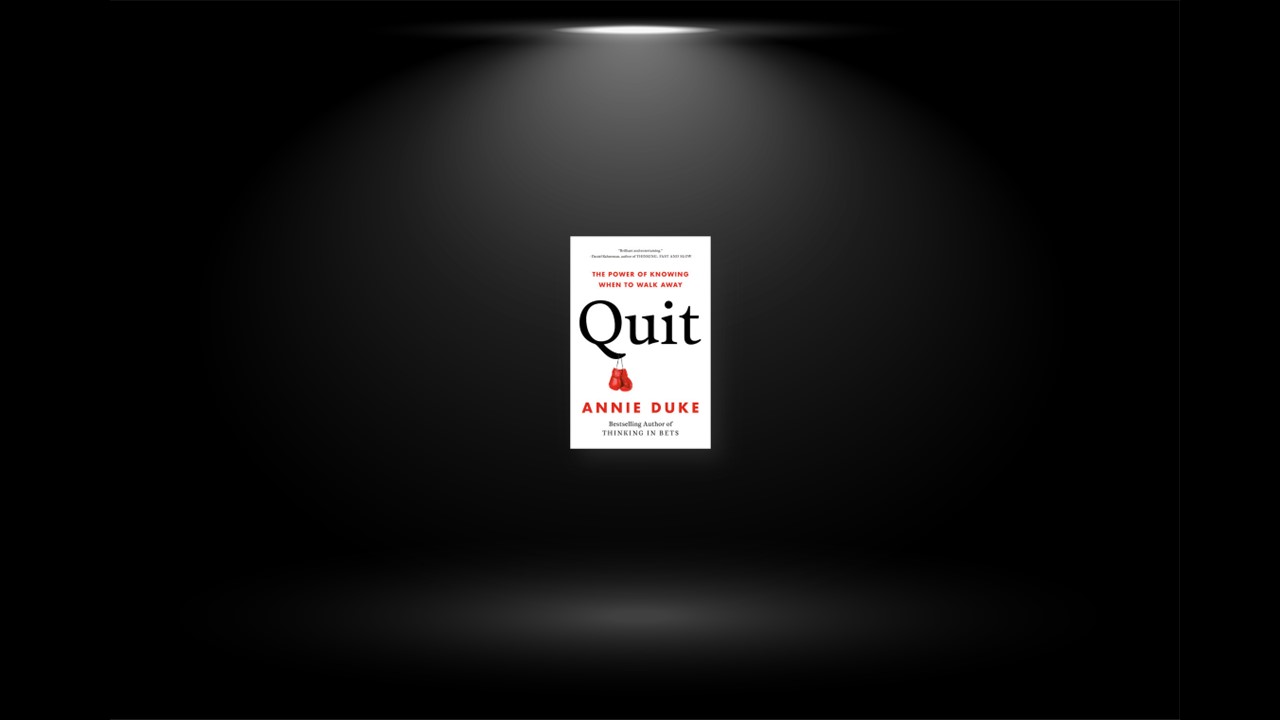The Opposite of a Great Virtue Is Also a Great Virtue
We tend to celebrate people who respond to adversity by soldiering on. The quitters, in comparison, are invisible. If we don’t notice the decision-making of the quitters, it’s hard to learn from them. Quitting a course of action is sometimes the best way to win in the long run, whether you’re cutting your losses at the poker table or getting to climb another day.
Decision-making in the real world requires action without complete information. Quitting is the tool that allows us to react to new information that is revealed after we make a decision.
Sticking with a course of action is the only way to find out for sure how it will turn out. Quitting requires being okay with not knowing what might have been. Having the option to quit helps you to explore more, learn more, and ultimately find the right things to stick with.
Quitting on Time Usually Feels Like Quitting Too Early
Quitting on time usually feels like quitting too early. The hardest time to make a quitting decision is when you’re in it.
Our intuition is that quitting will slow down our progress. The reverse is actually true. If you walk away from something that is no longer worthwhile, that frees you up to switch to something that is more likely to help you achieve your goals—and you’ll get there faster.
When the time is objectively right to quit, nothing particularly dire will be happening right at that moment. Getting the timing right means looking into the future and seeing that the chances things will go your way are too slim.
Thinking in expected value helps you figure out if the path you are on is worth sticking to. EV is not just about money. It can be measured in health, well-being, happiness, time, self-fulfillment, satisfaction in relationships, or anything else that affects you.
If you feel like the choice between persevering and walking away is a close call, it’s likely that quitting is the better choice. In hindsight, we can see when someone has waited too long to quit, and we tend to be harsh in our judgment of those people. But when someone quits before it seems obvious to others, we mock them for quitting too early. That’s the quitting bind.
Should I Stay, or Should I Go?
A key finding of prospect theory is loss aversion, the phenomenon whereby the emotional impact of a loss is greater than the corresponding impact of an equivalent gain. Loss aversion creates a preference for options associated with a lower chance of incurring a loss. It makes us risk averse.
When we are in the gains, we have a tendency to quit too early in order to avoid the risk of giving those gains back. In other words, we like to quit while we’re ahead. When we are in the losses, we become risk seekers. We want to keep going, hoping we can avoid ever having to realize the loss. Daniel Kahneman has characterized this as sure-loss aversion. In other words, we like to stick when we’re behind.
Quitting on time usually feels like quitting too early, and the usually part is specifically when you’re in the losses. Retail investors show this pattern of quitting when they’re ahead and sticking when they’re behind. Even expert investors don’t get their quitting decisions just right. They outperform on their buying decisions but underperform on their selling decisions.
We naturally track and get feedback on the things we are doing. But once we quit something, we also quit keeping track of that course of action. This creates a problem with getting high-quality feedback, which in turn makes it hard to hone our quitting skills.
Escalating Commitment
When we are in the losses, we are not only more likely to stick to a losing course of action, but also to double down. This tendency is called escalation of commitment.
Escalation of commitment is robust and universal, occurring in individuals, organizations, and governmental entities. All of us tend to get stuck in courses of action once started, especially in the face of bad news. Escalation of commitment doesn’t just occur in high-stakes situations. It also happens when the stakes are low, demonstrating the pervasiveness of the error.
Sunk Cost and the Fear of Waste
The sunk cost effect is a cognitive illusion where people take into account resources they have previously sunk into an endeavor when making decisions about whether to continue and spend more. The sunk cost effect causes people to stick in situations that they ought to be quitting.
When deciding whether to stick or quit, we are worried that if we walk away, we will have wasted the resources we have spent in the trying. You might be experiencing the sunk cost fallacy if you hear yourself thinking “If I don’t make this work I will have wasted years of my life!” or “We can’t fire her now, she’s been here for decades!”
Sunk costs snowball, like a katamari. The resources you have already spent make it less likely you will quit, which makes it more likely you will accumulate additional sunk costs, which makes it again less likely you will quit, and so on. The growing debris of your prior commitment makes it increasingly harder to walk away.
Knowing about the sunk cost effect doesn’t keep you from falling prey to it. You can’t trick yourself into not taking sunk costs into account by trying to view the situation as a new choice. Asking whether or not you would continue if the decision were a fresh one doesn’t mitigate the sunk cost effect the way you might intuitively think it would.
Endowment and Status Quo Bias
The endowment effect is a cognitive bias where we value something we own more than we would if we didn’t own it. We can be endowed to objects but also to our own ideas and beliefs. Endowment is an obstacle to quitting because when we irrationally value things we own, we miscalculate their expected value. We might think the company we started or the project we devised or the belief we have is worth more than it actually is.
We prefer to stick with the status quo. We are more tolerant of bad outcomes that come from sticking with what we are already doing than bad outcomes that come from switching to something new. This phenomenon is part of omission-commission bias. When you say, “I’m just not ready to decide yet,” what you are really saying is, “For now, I am choosing the status quo.” Even in highly data-rich environments like professional sports, sunk cost, endowment, and status quo bias distort decision-making.
Identity and Dissonance
When it comes to quitting, the most painful thing to quit is who you are. Our ideas, beliefs, and actions are part of our identity. When new information conflicts with a belief, we experience cognitive dissonance. To resolve the conflict, we can either change the belief or rationalize away the new information. Too often, we choose the latter.
Dissonance can also result from new information coming into conflict with our past actions. We have a desire to maintain internal consistency, where our past beliefs and actions line up with our present beliefs and actions. We also want others to view us as consistent. We worry that if others see inconsistency between our present and past decisions, beliefs, or actions, they will judge us as being wrong, irrational, capricious, and prone to mistakes. When we know or believe our decisions are being evaluated by others, our intuition is that we will be more rational, but the opposite is true. External validity increases escalation of commitment.
Find Someone Who Loves You but Doesn’t Care About Hurt Feelings
Optimism makes you less likely to walk away while not actually increasing your chances of success. That means that being overly optimistic will make you stick to things longer that aren’t worthwhile. Better to be well calibrated.
When someone is on the outside looking in, they can usually see your situation more rationally than you can. The best quitting coach is a person who loves you enough to look out for your long-term well-being. They are willing to tell you the hard truth even if it means risking hurt feelings in the short term.
Decisions about when to quit improve when the people who make the decisions to start things are different from the people who make the decisions to stop those things. Getting the most out of a quitting coach requires permission to speak the truth.
The Myopia of Goals
Goals can make it possible to achieve worthwhile things, but goals can also increase the chances that we will escalate commitment when we should quit. Goals are pass-fail in nature. You either reach the finish line or you don’t, and progress along the way matters very little.
Don’t just measure whether you hit the goal, ask what you have achieved and learned along the way. Set intermediate goals and prioritize goals that allow you to recognize progress along the way or acquire something valuable even if you don’t reach the goal. Goals, when set, are a proxy for an expected-value equation, balancing the benefits that you’re trying to gain against the costs you’re willing to bear.
Inflexible goals aren’t a good fit for a flexible world. With better advance planning and the help of a good quitting coach, you can make goals more flexible, setting at least one “unless” and planning regular check-ins on the analysis that initially led to setting the goal.


